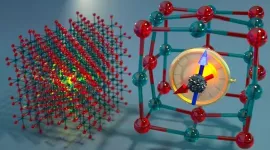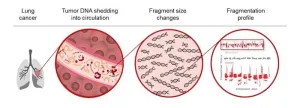(Press-News.org) Researchers at the University of Michigan and Brown University have developed a new computational method to analyze complex tissue data that could transform our current understanding of diseases and how we treat them.
Integrative and Reference-Informed tissue Segmentation, or IRIS, is a novel machine learning and artificial intelligence method that gives biomedical researchers the ability to view more precise information about tissue development, disease pathology and tumor organization.
The findings are published in the journal Nature Methods.
IRIS draws from data generated by spatially resolved transcriptomics and uniquely leverages single-cell RNA sequencing data as the reference to examine multiple layers of tissue simultaneously and distinguish various regions with unprecedented accuracy and computational speed.
Unlike traditional techniques that yield averaged data from tissue samples, SRT provides a much more granular view, pinpointing thousands of locations within a single tissue section. However, the challenge has always been to interpret this vast and detailed dataset, says Xiang Zhou, professor of biostatistics at the University of Michigan School of Public Health and senior author of the study.
Interpreting large and complex datasets is where IRIS becomes a helpful tool—its algorithms sort through the data to identify and segment various functional domains, such as tumor regions, and provide insights into cell interactions and disease progression mechanisms.
"Different from existing methods, IRIS directly characterizes the cellular landscape of the tissue and identifies biologically interpretable spatial domains, thus facilitating the understanding of the cellular mechanism underlying tissue function," said U-M doctoral alum Ying Ma, assistant professor of biostatistics at Brown University, who helped develop IRIS.
"We anticipate that IRIS will serve as a powerful tool for large-scale multisample spatial transcriptomics data analysis across a wide range of biological systems."
Zhou and Ma applied IRIS to six SRT datasets and compared its performance to other commonly used spatial domain methods. Ultimately, as SRT technology continues to grow in popularity and use, the researchers hope to see methods like IRIS help to potentially develop targets for clinical interventions or drug targets, improving personalized treatment plans and patient health outcomes.
"The computational approach of IRIS pioneers a novel avenue for biologists to delve into the intricate architecture of complex tissues, offering unparalleled opportunities to explore the dynamic processes shaping tissue structure during development and disease progression," Zhou said. "Through characterizing refined tissue structures and elucidating their alterations during disease states, IRIS holds the potential to unveil mechanistic insights crucial for understanding and combating various diseases."
The study was supported by grants from the National Institutes of Health.
Study: Accurate and efficient integrative reference-informed spatial domain detection for spatial transcriptomics
Written by Destiny Cook, U-M School of Public Health
END
Novel AI method could improve tissue, tumor analysis and advance treatment of disease
Research team hopeful that new computational statistics method can provide more detailed information for precision health treatment plans
2024-06-06
ELSE PRESS RELEASES FROM THIS DATE:
Omega-3 therapy prevents birth-related brain injury in newborn rodents
2024-06-06
NEW YORK, NY--An injectable emulsion containing two omega-3 fatty acids found in fish oil markedly reduced brain damage in newborn rodents after a disruption in the flow of oxygen to the brain near birth, a study by researchers at Columbia University Vagelos College of Physicians and Surgeons has found.
Brain injury due to insufficient oxygen is a severe complication of labor and delivery that occurs in one to three out of every 1,000 live births in the United States. Among babies who survive, the condition can lead to cerebral palsy, cognitive disability, epilepsy, pulmonary hypertension, and neurodevelopmental conditions.
“Hypoxic ...
Calcium oxide’s quantum secret: nearly noiseless qubits
2024-06-06
Calcium oxide is a cheap, chalky chemical compound commonly used in the manufacturing of cement, plaster, paper, and steel. But the material may soon have a more high-tech application.
UChicago Pritzker School of Molecular Engineering researchers and their collaborator in Sweden have used theoretical and computational approaches to discover how tiny, lone atoms of bismuth embedded within solid calcium oxide can act as qubits — the building blocks of quantum computers and quantum communication devices. These qubits are described today in Nature Communications.
“This system has even better properties than we expected,” said Giulia Galli, Liew Family Professor ...
Innovative combination therapy shows promise for bladder cancer patients unresponsive to standard treatment
2024-06-06
TAMPA, Fla. (June 6, 2024) — In a groundbreaking advance that could revolutionize bladder cancer treatment, a novel combination of cretostimogene grenadenorepvec and pembrolizumab has shown remarkable efficacy in patients with Bacillus Calmette-Guérin (BCG)-unresponsive non-muscle invasive bladder cancer. Results from the phase 2 CORE-001 trial, published today in Nature Medicine, reveal a significant improvement in complete response rates and long-term disease control, offering new hope for patients with this challenging condition who face limited treatment options.
The trial included patients with BCG-unresponsive carcinoma in situ of the bladder, a condition that is notoriously ...
SFU Physics collaboration pushes an information engine to its limits
2024-06-06
The molecules that make up the matter around us are in constant motion. What if we could harness that energy and put it to use?
Over 150 years ago Maxwell theorized that if molecules’ motion could be measured accurately, this information could be used to power an engine. Until recently this was a thought experiment, but technological breakthroughs have made it possible to build working information engines in the lab.
With funding from the Foundational Questions Institute, SFU Physics professors John Bechhoefer and David Sivak teamed up to build an information engine and test its limits. Their work has greatly advanced ...
Artificial intelligence blood test provides a reliable way to identify lung cancer
2024-06-06
Using artificial intelligence technology to identify patterns of DNA fragments associated with lung cancer, researchers from the Johns Hopkins Kimmel Cancer Center and other institutions have developed and validated a liquid biopsy that may help identify lung cancer earlier.
In a prospective study published June 3 in Cancer Discovery, the team demonstrated that artificial intelligence technology could identify people more likely to have lung cancer based on DNA fragment patterns in the blood. The study enrolled about 1,000 participants with and without cancer who met the criteria for traditional lung ...
The ethical matrix: it's not just smart; it's the smart thing to do
2024-06-06
Artificial Intelligence (AI) is the talk of the town, but far too often expediency has been the driver, not responsible innovation. The NYC Media Lab (NYCML) at NYU Tandon School of Engineering and Bertelsmann launched their 4th challenge this month, this time aimed at mentoring teams with projects that use AI to responsibly advance their fields.
The 2024 collaboration, The Ethical Matrix Challenge: Forging New AI Frontiers in Media, Communications, Education, and Healthcare, focuses on ethical AI and its power to have a real-world influence. The four selected teams have projects that can responsibly revolutionize the way ...
Study: Young athletes at risk for elevated blood pressure rates, future cardiovascular complications
2024-06-06
A substantial portion of young athletes are at risk of hypertension, according to a study presented at the American College of Cardiology’s Care of the Athletic Heart conference, taking place on June 6-8 in Washington.
High blood pressure, also known as hypertension, occurs in 47% of adults in the U.S., according to CardioSmart.org. Over time, hypertension weakens the heart, blood vessels and kidneys, paving the way for potential stroke or heart attack. Often referred to as the “silent killer,” high blood pressure is a leading risk factor for heart disease and early death.
The 2017 ACC/American Heart Association Guideline for the Prevention, ...
Mpox continues to circulate at low numbers among gay and bisexual men who have sex with men
2024-06-06
While mpox cases have sharply declined since the 2022 global outbreak, they continue to occur in the U.S. among gay and bisexual men who have sex with men (GBMSM), according to a UCLA-led study from EMERGEncy ID NET, a multisite surveillance network funded by the Centers for Disease Control and Prevention (CDC).
Though no cases were found in women, children or the unhoused, vigilance and vaccination remain important, the researchers write.
The findings will be published June 6 in the CDC’s Morbidity and Mortality Weekly Report.
Mpox, formerly known as monkeypox, ...
How the cell cycle orchestra plays an unexpected new tune
2024-06-06
How the Cell Cycle Orchestra Plays an Unexpected New Tune
UCSF scientists discover that multiciliated cells adapt the well-known process of cell division to make hundreds of cilia.
The awe-inspiring process of cell division can turn a fertilized egg into a baby – or a cancerous cell into a malignant tumor. With so much at stake, nature keeps it tightly controlled in a process called the cell cycle that scientists thought they thoroughly understood.
But now it turns out there was more to know. Scientists ...
Exotic black holes could be a byproduct of dark matter
2024-06-06
For every kilogram of matter that we can see — from the computer on your desk to distant stars and galaxies — there are 5 kilograms of invisible matter that suffuse our surroundings. This “dark matter” is a mysterious entity that evades all forms of direct observation yet makes its presence felt through its invisible pull on visible objects.
Fifty years ago, physicist Stephen Hawking offered one idea for what dark matter might be: a population of black holes, which might have formed very soon after the Big Bang. Such “primordial” black holes would not have been the goliaths that we detect today, but ...
LAST 30 PRESS RELEASES:
Making lighter work of calculating fluid and heat flow
Normalizing blood sugar can halve heart attack risk
Lowering blood sugar cuts heart attack risk in people with prediabetes
Study links genetic variants to risk of blinding eye disease in premature infants
Non-opioid ‘pain sponge’ therapy halts cartilage degeneration and relieves chronic pain
AI can pick up cultural values by mimicking how kids learn
China’s ecological redlines offer fast track to 30 x 30 global conservation goal
Invisible indoor threats: emerging household contaminants and their growing risks to human health
Adding antibody treatment to chemo boosts outcomes for children with rare cancer
Germline pathogenic variants among women without a history of breast cancer
Tanning beds triple melanoma risk, potentially causing broad DNA damage
Unique bond identified as key to viral infection speed
Indoor tanning makes youthful skin much older on a genetic level
Mouse model sheds new light on the causes and potential solutions to human GI problems linked to muscular dystrophy
The Journal of Nuclear Medicine ahead-of-print tip sheet: December 12, 2025
Smarter tools for peering into the microscopic world
Applications open for funding to conduct research in the Kinsey Institute archives
Global measure underestimates the severity of food insecurity
Child survivors of critical illness are missing out on timely follow up care
Risk-based vs annual breast cancer screening / the WISDOM randomized clinical trial
University of Toronto launches Electric Vehicle Innovation Ontario to accelerate advanced EV technologies and build Canada’s innovation advantage
Early relapse predicts poor outcomes in aggressive blood cancer
American College of Lifestyle Medicine applauds two CMS models aligned with lifestyle medicine practice and reimbursement
Clinical trial finds cannabis use not a barrier to quitting nicotine vaping
Supplemental nutrition assistance program policies and food insecurity
Switching immune cells to “night mode” could limit damage after a heart attack, study suggests
URI-based Global RIghts Project report spotlights continued troubling trends in worldwide inhumane treatment
Neutrophils are less aggressive at night, explaining why nighttime heart attacks cause less damage than daytime events
Menopausal hormone therapy may not pose breast cancer risk for women with BRCA mutations
Mobile health tool may improve quality of life for adolescent and young adult breast cancer survivors
[Press-News.org] Novel AI method could improve tissue, tumor analysis and advance treatment of diseaseResearch team hopeful that new computational statistics method can provide more detailed information for precision health treatment plans

